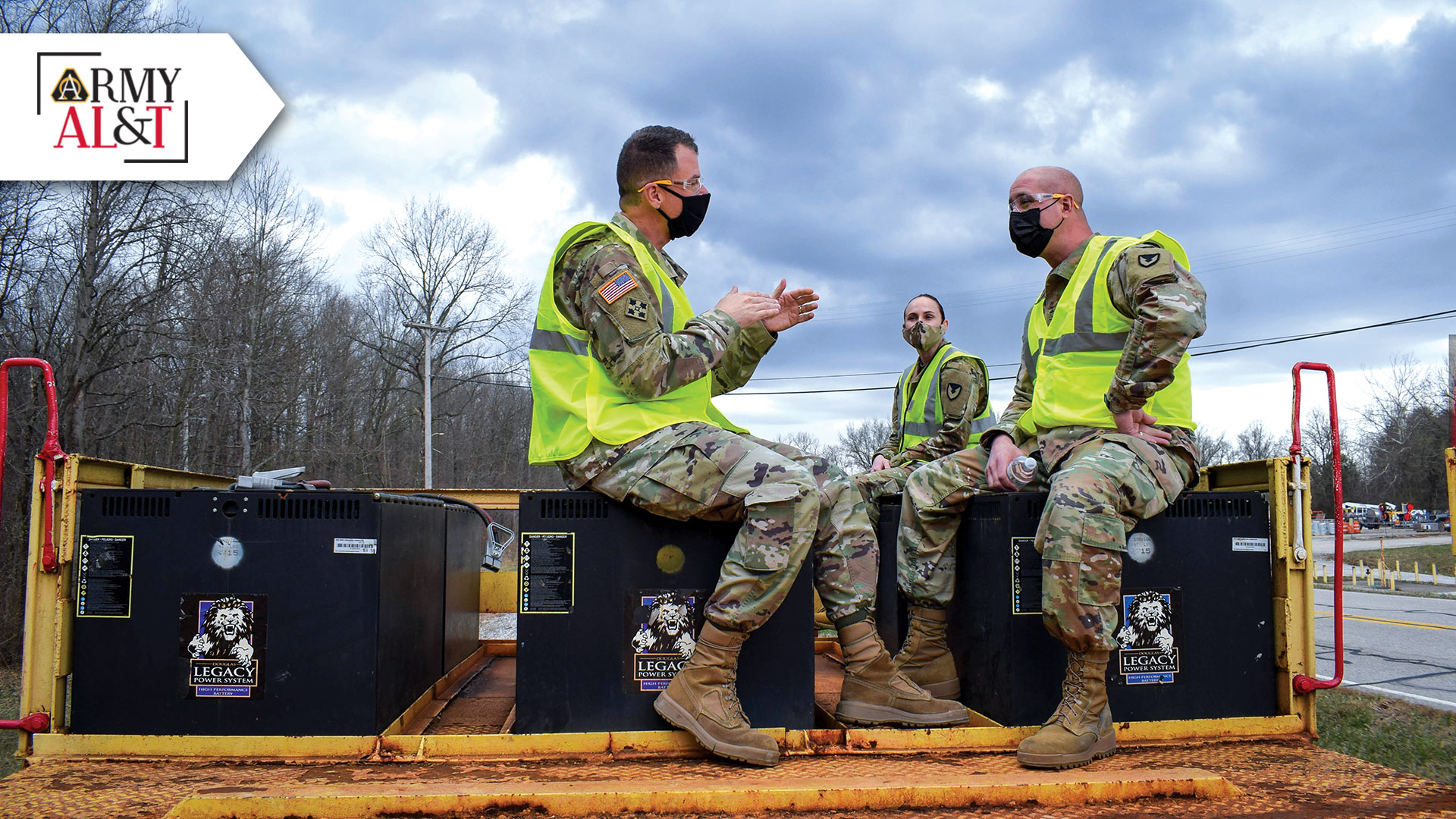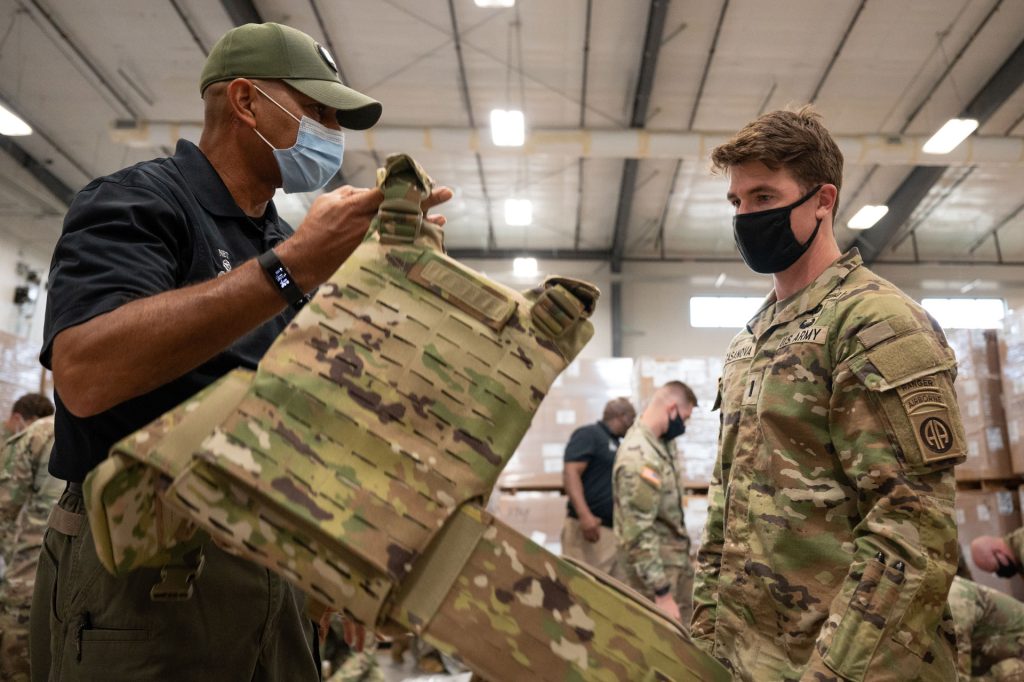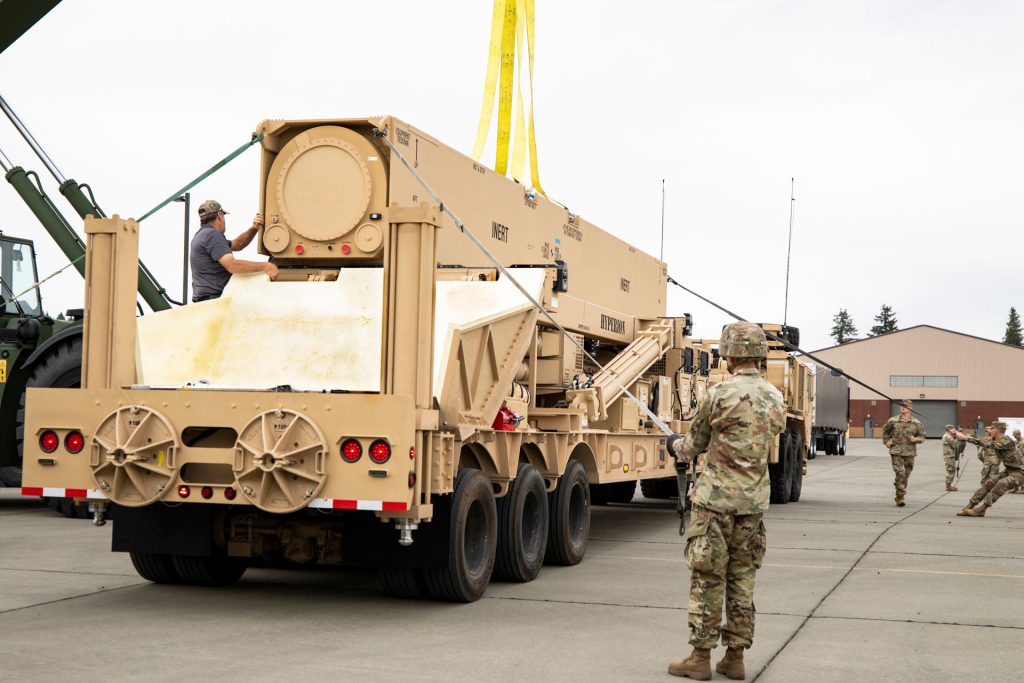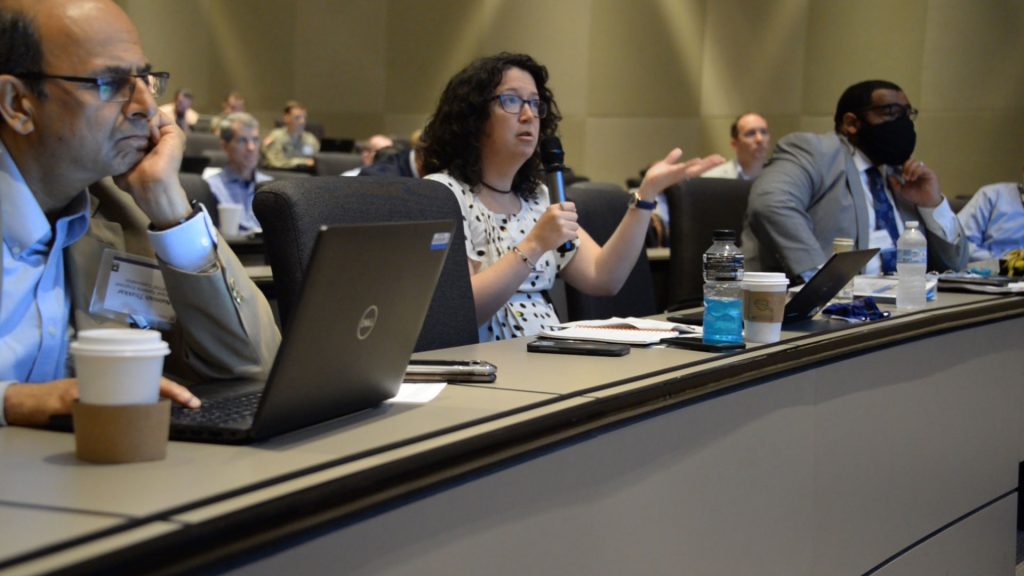
ON THE RIGHT TRACK: Col. Gavin Gardner, left, commander of Joint Munitions Command, rode the rails with Capt. Danielle Chavarria, center, and Col. Stephen Dondero, right, commander of Crane Army Ammunition Activity in Indiana, during a visit to the installation’s new shipping and receiving facility. (Photo by Lindsay Grant, Crane Army Ammunition Activity)
From the Army Acquisition Executive
Karen D.H. Saunders
New Adaptive Acquisition Framework provides pathways to simplify and expedite capability requirements.

It is often said that modernization is a team sport because it takes the entire team to succeed—communicating, collaborating, integrating and synchronizing all of the moving parts. That’s what we call the materiel enterprise—from science and technology to prototyping and experimentation, from requirements generation and refinement to materiel development and production, fielding and, ultimately, sustainment and divestiture.
Our roles are distinct but complementary ways to achieve the Army’s modernization while providing our joint warfighters with the best equipment possible in the event our Army, on behalf of the nation, has to go to war.
As Secretary of the Army Christine Wormuth noted in her opening remarks at the Association of the United States Army Annual Meeting and Exposition in October 2021,
“We have substantially transformed how the Army modernizes and develops new weapons systems.” And we, the acquisition community, partnering with Army Futures Command, Army Materiel Command and industry, do this by leveraging new authorities and policies as well as implementing transformative business practices.
The Army Acquisition, Logistics and Technology team comprises more than 42,000 professionals within the Army Acquisition Corps and the greater Army Acquisition Workforce. We develop, acquire and DELIVER materiel solutions that meet the operational requirements defined for the joint warfighter. As the Army’s acquisition decision authority, I am focused on the practical and successful EXECUTION of more than 500 programs throughout the acquisition life cycle. Further, as the Army’s modernization priorities evolve into programs, the Army acquisition community will continue its vital life cycle management role.
Over the past several years, DOD acquisition has gone through a significant overhaul. We have seen transformational change in the department’s acquisition authorities and policies, which will have enduring positive effects on acquiring and sustaining warfighter capabilities.
The goal of the Defense Acquisition System is to afford program teams the flexibility to tailor approaches based on the capability being acquired—this empowers critical thinking and commonsense decision-making and, most importantly, accelerates delivery timelines to move with speed and relevancy.

INVESTING IN MSV: Alexander Pillot, a new equipment trainer assigned to the Program Executive Office (PEO) for Soldier, hands a second-generation Modular Scalable Vest (MSV) to a Soldier during a fielding event in Fort Bragg, North Carolina. The 82nd Airborne Division is the first to receive all eight sizes of the second-generation MSV. (Photo by Jason Amadi, PEO Soldier)
A FRAMEWORK FOR SUCCESS
Thanks to a thorough revamp of the DOD 5000 series of instructions, this new, flexible and tailored approach has been instantiated in the new Adaptive Acquisition Framework (AAF).
By design, this framework provides six pathways that simplify policy, tailor approaches, empower program managers, facilitate data-driven analysis, actively manage risk and emphasize sustainment.
We are taking advantage of each of the AAF pathways today. For example, with the middle tier of acquisition (MTA), the focus is on speed: authority for requirements and acquisition oversights are pushed down, and funding is provided for smaller capability increments.
As a result, programs rapidly develop fieldable prototypes to demonstrate new capabilities or rapidly field production quantities of systems with proven technology requiring minimum development within five years.
This fall, we approach the five-year mark of initiating MTA programs in the Army. Currently, we have 19 efforts leveraging the MTA pathway to rapidly prototype or rapidly field mature technology: 15 programs are in rapid prototyping and four are in rapid fielding—and we see good results.
In addition to MTA, we are finding increased value in the new software acquisition pathway, already initiating six new programs—three in the planning phase and three in the execution phase.
Recognizing that modern software development is a continuum of development, production, operations and sustainment, the software acquisition pathway is built upon industry best practices. This pathway enables innovation and swift delivery in response to conditions of uncertainty, such as rapidly changing user needs, disruptive technologies and evolving threats.
With both the MTA and software pathways, program teams are empowered to start quickly and iterate on requirements and subsequent delivery. By doing so, we are getting capability into our Soldiers’ hands as soon as possible and receiving feedback. This allows us to make the best possible decisions with as much information as possible instead of locking ourselves into strategies early in the life cycle, impacting our costs, schedules and performance.
In addition to AAF and its supporting policies, we have also significantly increased efficiency and acquisition speed through a number of contracting reforms.
Along with reducing Defense Federal Acquisition Regulation Supplement regulations from OSD, we have also benefitted from contracting flexibilities with permanent authority to award other-transaction authority agreements for research, prototyping and production purposes.
Other-transaction authority gives the Army the flexibility necessary to incorporate standards and best practices from commercial industry into our award instruments.
Exercising this authority speeds prototyping to production and fosters increased collaboration with our industry partners earlier in the process than when using more traditional acquisition approaches.
The new acquisition and procurement authorities being implemented today by the Office of the Assistant Secretary of the Army for Acquisition, Logistics and Technology support the modernization priorities and the 31 + 4 signature efforts and their enablers. They also support new business processes and enhance our focused partnerships with Army Futures Command to ensure strong connections between our operators and our acquisition professionals to place Soldier-centered design at the heart of the modernization process.
Acquisition and sustainment are equally important in providing the required warfighting capability when and where needed—and product support bridges the gap between these two critical functionalities.

SPECIAL DELIVERY: The first prototype hypersonic hardware was delivered to Soldiers of the 5th Battalion, 3rd Field Artillery Regiment, 17th Field Artillery Brigade in October 2021. Hypersonics is part of the Army’s No.1 modernization priority of long-range precision fires, and is one of the highest priority modernization areas DOD is pursuing. (Photo by Spc. Karleshia Gater, I Corps (photo edited))
CONCLUSION
On average, over the life cycle of a program, 70 cents on the dollar will be spent on sustainment and operations.
With this in mind, we must continue to emphasize the importance of designing for sustainment to reduce the demand for logistics support and maximize the availability of systems over their long life cycles.
In other words, sustainment requirements must be “baked in” to the design of a materiel solution to deliver long-term operational availability and to better support warfighter requirements. Our partnership with Army Materiel Command is paramount early in design and development, as they are responsible for the sustainment and eventual disposal.
The acquisition community also works very closely with industry to develop capability. We value the partnership, innovative development processes, and research and development investments to move us forward in the life cycle continuum to ensure the Army succeeds.
Through our distinct yet complementary roles and functions, and new authorities, policies and processes, we are postured as the Army materiel enterprise to modernize the Army to win the great power competition.

TECHNOLOGY IS A TEAM EFFORT: The Army’s Rapid Capabilities and Critical Technologies Office held its Army Strategic Rapid Acquisition competition in June 2021, inviting companies and academic institutions to share their best ideas for emerging military technology. (Photo by John Higgins, PEO for Intelligence, Electronic Warfare and Sensors)







